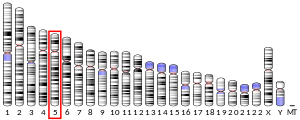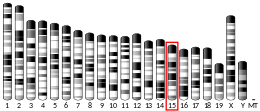60S ribosomal protein L37
60S ribosomal protein L37 is a protein that in humans is encoded by the RPL37 gene.[5][6][7]
Ribosomes, the organelles that catalyze protein synthesis, consist of a small 40S subunit and a large 60S subunit. Together these subunits are composed of 4 RNA species and approximately 80 structurally distinct proteins. This gene encodes a ribosomal protein that is a component of the 60S subunit. The protein belongs to the L37E family of ribosomal proteins. It is located in the cytoplasm. The protein contains a C2C2-type zinc finger-like motif. As is typical for genes encoding ribosomal proteins, there are multiple processed pseudogenes of this gene dispersed through the genome.[7]
References
- GRCh38: Ensembl release 89: ENSG00000145592 - Ensembl, May 2017
- GRCm38: Ensembl release 89: ENSMUSG00000041841 - Ensembl, May 2017
- "Human PubMed Reference:". National Center for Biotechnology Information, U.S. National Library of Medicine.
- "Mouse PubMed Reference:". National Center for Biotechnology Information, U.S. National Library of Medicine.
- Barnard GF, Staniunas RJ, Puder M, Steele GD Jr, Chen LB (Sep 1994). "Human ribosomal protein L37 has motifs predicting serine/threonine phosphorylation and a zinc-finger domain". Biochim Biophys Acta. 1218 (3): 425–8. doi:10.1016/0167-4781(94)90197-x. PMID 7545944.
- Kenmochi N, Kawaguchi T, Rozen S, Davis E, Goodman N, Hudson TJ, Tanaka T, Page DC (Aug 1998). "A map of 75 human ribosomal protein genes". Genome Res. 8 (5): 509–23. doi:10.1101/gr.8.5.509. PMID 9582194.
- "Entrez Gene: RPL37 ribosomal protein L37".
Further reading
- Wool IG, Chan YL, Glück A (1996). "Structure and evolution of mammalian ribosomal proteins". Biochem. Cell Biol. 73 (11–12): 933–47. doi:10.1139/o95-101. PMID 8722009.
- Su S, Bird RC (1995). "Cell cycle, differentiation and tissue-independent expression of ribosomal protein L37". Eur. J. Biochem. 232 (3): 789–97. doi:10.1111/j.1432-1033.1995.tb20874.x. PMID 7588717.
- Uechi T, Tanaka T, Kenmochi N (2001). "A complete map of the human ribosomal protein genes: assignment of 80 genes to the cytogenetic map and implications for human disorders". Genomics. 72 (3): 223–30. doi:10.1006/geno.2000.6470. PMID 11401437.
- Yoshihama M, Uechi T, Asakawa S, et al. (2002). "The Human Ribosomal Protein Genes: Sequencing and Comparative Analysis of 73 Genes". Genome Res. 12 (3): 379–90. doi:10.1101/gr.214202. PMC 155282. PMID 11875025.
- Strausberg RL, Feingold EA, Grouse LH, et al. (2003). "Generation and initial analysis of more than 15,000 full-length human and mouse cDNA sequences". Proc. Natl. Acad. Sci. U.S.A. 99 (26): 16899–903. doi:10.1073/pnas.242603899. PMC 139241. PMID 12477932.
- Schwartz EI, Intine RV, Maraia RJ (2004). "CK2 Is Responsible for Phosphorylation of Human La Protein Serine-366 and Can Modulate rpL37 5′-Terminal Oligopyrimidine mRNA Metabolism". Mol. Cell. Biol. 24 (21): 9580–91. doi:10.1128/MCB.24.21.9580-9591.2004. PMC 522270. PMID 15485924.
- Gerhard DS, Wagner L, Feingold EA, et al. (2004). "The Status, Quality, and Expansion of the NIH Full-Length cDNA Project: The Mammalian Gene Collection (MGC)". Genome Res. 14 (10B): 2121–7. doi:10.1101/gr.2596504. PMC 528928. PMID 15489334.
- Ewing RM, Chu P, Elisma F, et al. (2007). "Large-scale mapping of human protein–protein interactions by mass spectrometry". Mol. Syst. Biol. 3 (1): 89. doi:10.1038/msb4100134. PMC 1847948. PMID 17353931.
External links
- Overview of all the structural information available in the PDB for UniProt: P61927 (Human 60S ribosomal protein L37) at the PDBe-KB.
This article is issued from Wikipedia. The text is licensed under Creative Commons - Attribution - Sharealike. Additional terms may apply for the media files.



